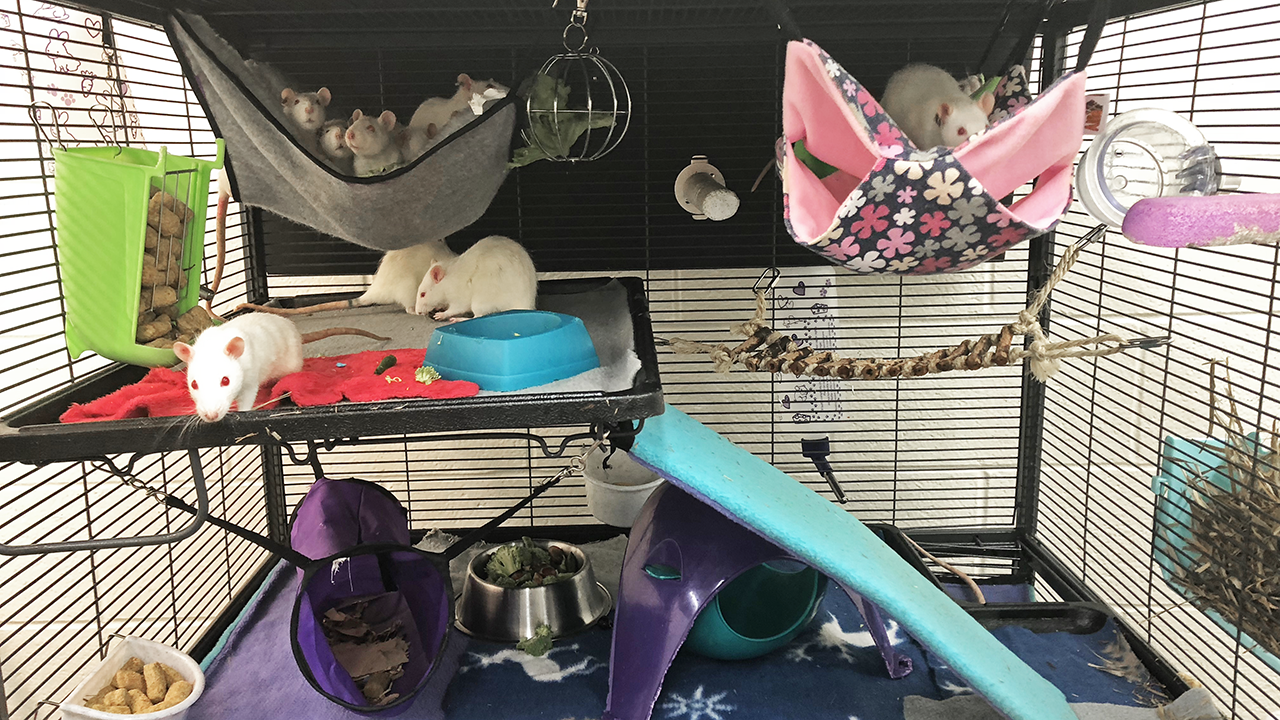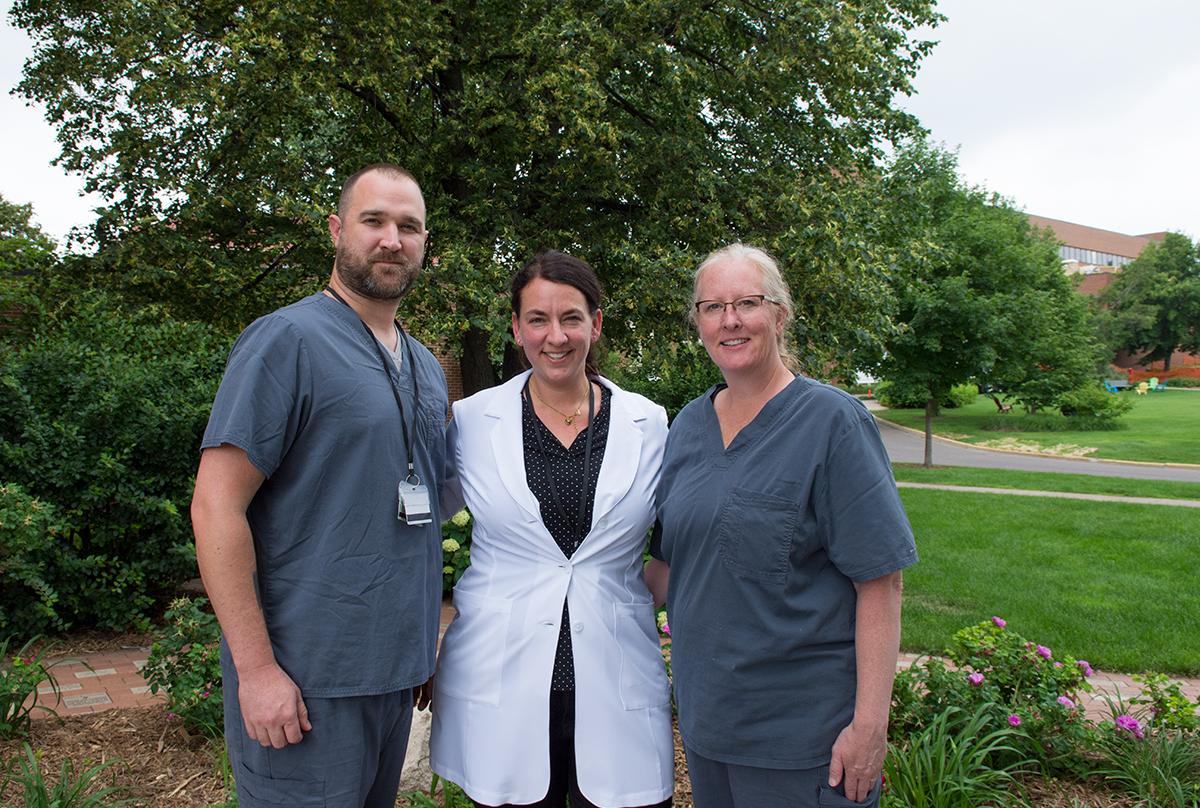
For Melanie Graham, MPH, Ph.D., making scientific progress while also respecting animals’ inherent value as living beings isn’t just possible—it’s essential.
“What interests me is care and compassion for humans and animals,” said Graham, associate professor of surgery in the University of Minnesota’s Medical School. “I believe there is a balance that is capable of promoting animal welfare and making biomedical progress in ways that will change lives.”
Nearly every medical treatment, medical device, and diagnostic tool available today was developed with the help of animals in research, from heart transplants to chemotherapy. Future treatments and cures for some of today’s most debilitating illnesses, like multiple sclerosis, brain cancer, and depression, will likely also rely on progress made through animal research.
As an institution, the U of M is dedicated to fostering a culture of ethical animal research. This commitment comes in many forms, from conducting researcher training to following all animal use policies and regulations established by federal agencies, an international accreditor, and the University itself. At the heart of the effort to ensure ethical practices is the Institutional Animal Care and Use Committee (IACUC). IACUC ensures the use of animals for research, teaching, and other purposes is ethically and scientifically justified, and that the animals are cared for responsibly and humanely. The committee reviews research programs, inspects facilities, and investigates concerns.
Graham joined IACUC back in 2006 as a scientific member and now serves as its co-chair. Her attention to animal research, however, began well before she joined the faculty at the U. Her Ph.D. was based in animal modeling, welfare, and refinement.
“Medicine in all of its forms has played a key role in increasing well-being and healthy life expectancy in animals and humans, to the extent that the right to health is a key component of modern society,” Graham said. “I was very aware that these advances in medicine relied heavily on research using animals, and I was interested in making an impact on the lives of animals being used.”
Guiding Principles for Ethical Research
At the heart of the guidelines that Graham and many other researchers follow in conducting animal research are the “3Rs”—replacement, reduction, and refinement. Graham, who has studied and written about the 3Rs, said the model balances animals’ needs with researchers’ scientific aims, appreciating the ethical complexity around the question of using animals in research.
Two tenets of the 3Rs, reduction and replacement, center on the idea of finding alternatives to animal research when possible. Valid alternatives are gradually increasing, Graham said, and are changing how the next generation of scientists are trained. That said, the specific question researchers are trying to answer will determine whether or not an alternative is possible.
Computer modeling or cell lines can be great for suggesting the immediate outcome of a treatment, but in-animal studies may be required to understand how it affects the body as a living system. Will a diabetes treatment targeting the pancreas cause problems for the heart? Determining this risk before clinical trials begin is crucial for human safety.
Another tenet, refinement, works to improve animals’ role in research when no alternative fits. For example, researchers can often test a treatment in cell cultures before testing it in animals, sparing the need to use animals if the treatment fails early on.
The 3Rs are a core part of the institutional training at the U of M and institutions across the US, recognized both for their role in ensuring animal welfare and in producing better science. The model continues to evolve, Graham said, as researchers are always exploring ways they to refine and reduce their reliance on animal models.
“The reality of making a difference or creating an excellent experience is usually a cumulation of small moments and interactions, going in the right direction because they are performed by people who are committed to this mission,” Graham said. “Our animals are not ‘instruments’; there is a power in everyday mindfulness, kindness, and respect for their intrinsic value as animals.”
Cooperating with the Animals
Patients with chronic disease live with the burden of their disease, but also the everyday challenges of medical intervention. In studying these diseases, researchers face similar demands with their animals, with the added requirements that treatments and tests for efficacy and safety testing impose. Graham’s lab was the first to clearly demonstrate that animals, especially primates, can be trained to routinely cooperate with caregivers in highly complex examinations and therapies, which was considered remarkable at a time when restraint was the norm in working with animals.
Medical procedures, like blood draws or injections (which are essential in managing diabetes), in humans and animals can lead to anxiety. Additionally, restraining animals for these procedures triggers a profound stress response, leading to changes in metabolic and immune responses. These changes can throw off test results and make it harder to accurately predict whether a given treatment might work in humans.
Graham has objectively demonstrated through studies that her refined handling and husbandry methods are effective in improving animal well-being while producing better science. This refined animal model supported long-term diabetes reversal after transplant in primates using an unlimited source of cells that produce insulin—a hormone that the human body needs to manage blood sugar levels and that Type 1 diabetics cannot produce on their own. The achievement added to the long string of “firsts” in transplantation medicine developed at the University of Minnesota.
With the help of animal models, Graham is now exploring ways to transplant these cells without the standard toxic drugs used to keep the body from attacking cells that it thinks are not its own—which would broaden the reach of patients who stand to benefit.

A Team Effort, a Caring Environment
Animal research carries many responsibilities. Like other facilities at the U that conduct animal research, Graham’s lab is a highly regulated environment. There are over 500 standard operating procedures and forms that staff must follow to ensure both the welfare of the animals as well as the quality and rigor of the research. Regulatory bodies visit frequently to inspect and verify the lab meets or exceeds standards.
It’s a team effort that promotes this animal-centric culture. Staff and students are dedicated to specialized animal care and research tasks, while University veterinarians regularly provide expert care and monitor animals’ health and well-being to help the team make the best decisions about housing, activities, and diet. The team is careful to consider the animals perspective in introducing new procedures or environmental changes. They also learn about the animals’ preferences, going through exercises that allow each one to choose their favorite caregivers, diets, play activities, and social partners to bond with animals in their care.
To balance research activities, the animals benefit from enrichment. Rats and monkeys, for example, are housed in spaces where they can forage, climb, swim, and socialize, following their instinctual behaviors. The staff regularly re-outfits these cages with different structures and toys to give animals something new and interesting to explore. Other features, like theater lighting to simulate the cycles of sunrise and sunset and natural sounds, fostering an immersive, semi-naturalistic environment that helps make animals comfortable.
All of this attention to the animals’ experience, Graham said, is important to advancing the state of animal research and keeping ethics top-of-mind, so that the University can act as a leader in ethical animal research.
“I believe that we can positively impact the way our animals experience the research environment, and in doing this enhance the science to accelerate new cures, and create a ripple effect beyond the U of M,” she said.
Top photo credit: Preclinical Research Center, Department of Surgery, University of Minnesota